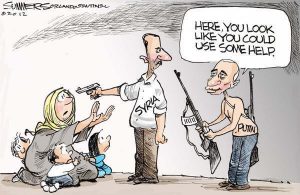The Syrian military does not have enough personnel to simultaneously launch major attacks, suppress militants, and garrison cities under its control, and so Moscow has dispatched to Syria irregular forces which it calls “the Spetznaz of the USSR” that consist not of professional soldiers but of irregulars from Central Asia and the Caucasus.
According to the RusVesna (Russian Spring) portal, which was launched at the time of the Crimean Anschluss
, this force, which it labels “a counter-guerrilla special detachment from the countries of the former USSR,” calls itself TURAN, has its own uniforms and numbers between 800 and 1200 fighters.
Most of the participants come from Central Asia and the South Caucasus, but some come from the North Caucasus as well, the portal says. They are armed with weapons from the former Soviet Union as well as the West, and they appear to “belong to the now fashionable innovation of contemporary war – private military companies.”
 Its commanders say, RusVesna reports, that they will soon be sending up to 400 of their number along the road connecting Aleppo and Deir ez-Zor in support of government forces.
Its commanders say, RusVesna reports, that they will soon be sending up to 400 of their number along the road connecting Aleppo and Deir ez-Zor in support of government forces.
And the portal adds that “the appearance of such departments on the side of government forces should become a signal for the militants that against them are fighting representatives of a good half of the countries of the former USSR which in turn means the following: the days of their bandit activities on the Syrian land are numbered.”
The participation of as many as 10,000 militants from Russia and the other post-Soviet states has attracted enormous attention as has the Russian military presence not only in the form of regular units but also Chechen police detachments that Ramzan Kadyrov
has loudly promised he has sent.
But this new Russian-organized “special forces” group is ominous for three reasons:
- First, such nominally irregular fighters because their activities can be denied not only by Damascus but by Moscow as well are likely to engage in even more vicious actions than the regular units of both.
- Second, their appearance may help Bashar Assad in the short term but they almost certainly guarantee that Russian involvement in his regime will be far more long-lasting than many have thought, with units of this “Spetznaz of the USSR” integrating themselves into the Syrian control system again in deniable ways.
- And third, and perhaps most worrisome of all, such units may represent a model for future Russian behavior in other hotspots, where most attention will focus on militants fighting for Islamist causes rather than on irregulars fighting for dictatorial regimes which are now Moscow’s only allies.
Related:
- West fails to recognize nature and scope of Putin's hybrid war against it, Eidman says
- The ordinary fascism
- Moscow scrambling to fill ranks of its forces in Syria and elsewhere
- Ukraine, Syria, and Putin
- Chechen and Afghan echoes of Putin’s military operation in Syria
- How Russia tried to cover up death of Putin’s best helicopter ace in Syria
- The 75 Russian military units at war in Ukraine
- Russian military analyst: The forces in Donbas are Russian Army
- Soloshenko: What imprisoned Russian army officers told me…

